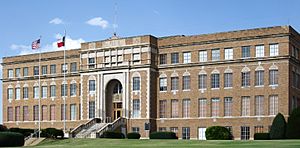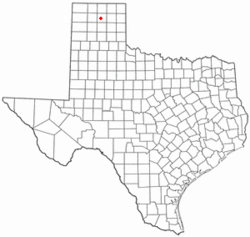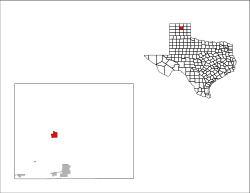Stinnett, Texas facts for kids
Quick facts for kids
Stinnett, Texas
|
|
|---|---|

Hutchinson County Courthouse
|
|

Location of Stinnett, Texas
|
|
 |
|
| Country | United States |
| State | Texas |
| County | Hutchinson |
| Area | |
| • Total | 1.98 sq mi (5.14 km2) |
| • Land | 1.98 sq mi (5.14 km2) |
| • Water | 0.00 sq mi (0.00 km2) |
| Elevation | 3,176 ft (968 m) |
| Population
(2020)
|
|
| • Total | 1,650 |
| • Density | 833/sq mi (321.0/km2) |
| Time zone | UTC-6 (Central (CST)) |
| • Summer (DST) | UTC-5 (CDT) |
| ZIP code |
79083
|
| Area code(s) | 806 |
| FIPS code | 48-70340 |
| GNIS feature ID | 2411984 |
| Website | cityofstinnett.com |
Stinnett is a small city located in Hutchinson County, Texas, in the United States. It is known as the county seat of Hutchinson County. This means it is where the main government offices for the county are located. In 2020, about 1,650 people lived in Stinnett.
Contents
History of Stinnett
Stinnett was founded in 1926 by two brothers, A.P. (Ace) Borger and Lester Andrew (Pete) Borger. Ace Borger is also famous for starting the larger city of Borger in the same county.
In September 1926, Stinnett became the new county seat for Hutchinson County. It took over this role from a place called Plemons, which later became a ghost town (a town that is no longer inhabited).
Building the Courthouse
The county courthouse in Stinnett was built in 1927. Its design is in the Spanish Renaissance style, which is a type of architecture. The money to build this important building came from petroleum, also known as oil. The courthouse was designed by an architect named W.F. Townes. It is made of brown brick and white stone.
Geography and Climate
Stinnett is located in Texas. The city covers an area of about 2.0 square miles (5.14 square kilometers). All of this area is land.
What is the Climate Like?
Stinnett has a semiarid climate. This means it is generally dry, but not as dry as a desert. It often has hot summers and mild winters.
Population of Stinnett
The number of people living in Stinnett has changed over the years. Here is how the population has grown and shrunk:
| Historical population | |||
|---|---|---|---|
| Census | Pop. | %± | |
| 1930 | 377 | — | |
| 1940 | 635 | 68.4% | |
| 1950 | 1,170 | 84.3% | |
| 1960 | 2,695 | 130.3% | |
| 1970 | 2,014 | −25.3% | |
| 1980 | 2,222 | 10.3% | |
| 1990 | 2,166 | −2.5% | |
| 2000 | 1,936 | −10.6% | |
| 2010 | 1,881 | −2.8% | |
| 2020 | 1,650 | −12.3% | |
| U.S. Decennial Census | |||
Who Lives in Stinnett?
The 2020 United States census showed that 1,650 people lived in Stinnett. There were 521 households and 367 families. The people living in Stinnett come from different backgrounds.
| Group | Number of People | Percentage |
|---|---|---|
| White (Non-Hispanic) | 1,268 | 76.85% |
| Black or African American (Non-Hispanic) | 15 | 0.91% |
| Native American or Alaska Native (Non-Hispanic) | 23 | 1.39% |
| Asian (Non-Hispanic) | 3 | 0.18% |
| Other Race (Non-Hispanic) | 2 | 0.12% |
| Mixed/Multi-Racial (Non-Hispanic) | 95 | 5.76% |
| Hispanic or Latino | 244 | 14.79% |
| Total | 1,650 |
Education in Stinnett
Students in Stinnett attend schools that are part of the Plemons-Stinnett-Phillips Consolidated Independent School District. Before July 1, 1987, Stinnett had its own school district called Stinnett Independent School District. It then joined with other districts to form the current one.
Famous People from Stinnett
- Donny Anderson: He was a professional NFL player. Even though he was born in Borger, he graduated from Stinnett High School in 1961.
See also
 In Spanish: Stinnett (Texas) para niños
In Spanish: Stinnett (Texas) para niños


